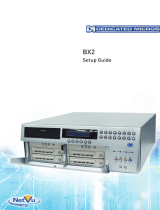11
ENGLISH
Connecting to an Ethernet network
Digital Sprite 2 includes an enhanced video server allowing remote
connectivity across an Ethernet network. Multiple users can connect
simultaneously to the Digital Sprite 2 to view and control live or recorded video,
download recorded images or review database details.
The Digital Sprite 2 can be connected to a standard 10/100-baseT Ethernet
network and using the viewing application offers full control of the unit from a
remote location.
Network Connection
To connect a Digital Sprite 2 to a network you will need the following items:
• One RJ-45 network cable (CAT5 or equivalent).
• A static or DHCP IP address and Subnet mask (if accessed from beyond the
LAN, a Default gateway IP address will also be needed. Consult the network
administrator for advice).
Refer to the Network Options in the Configuration section for full details on
how to configure the units IP address.
Viewing images across the network
Digital Sprite 2 can use either a Web interface or network viewing software to
view images across the network.
The network viewing software can be downloaded directly from the unit onto
your local PC using the network connection, see below for details.
The recommended PC specification for viewing images over a network is:
• Pentium IV, 1.8GHz processor.
• 256MB RAM.
• 8MB of Video RAM.
• 16 Bit sound card for audio support.
• 1024 x 768 x 32bit colour monitor (min).
• 10/100Mbit Ethernet half duplex network interface card.
• Windows 2000, Windows XP.
• Internet Explorer 6 or Netscape Navigator 7.1.
Although the system will operate on lower specification computers this
standard will provide high performance video quality and update rates. If lower
specification processors are used this will affect the overall performance of the
computer.
Downloading the Viewer from the Unit
To connect to the Digital Sprite 2 for downloading the Viewing application:
1. Open your web browser on your PC.
2. Enter the IP address of the Digital Sprite 2 in the ‘Address’ box of Internet
Explorer or Netscape and press Enter. Remove all preceding 0’s, i.e.
123.123.123.001 in the Digital Sprite 2 should be entered as 123.123.123.1
in the web browser.
Note: If a password has been configured it will be necessary to enter the
Username and Password information to gain access to the unit. The default
user name and password are dm and web.
3. The main web page from the Digital Sprite 2 will be loaded. Click on the
‘Downloads’ option you will be presented with three options:
Viewer Software
System Manuals
Language Files
4. The PC will require Java Runtime Environment to be installed. To install the
JRE and viewer application, select Viewer Software and press the link for
the appropriate file (
jre-x_x_x_x-windows.). Follow the on-screen
instructions.
5. Go back to the Downloads menu and select the System Manuals option,
download the NetVu ObserVer User Guide (.pdf).
6. Go back to the Downloads menu and select ‘Viewer Software’, select the
NetVu ObserVer windows link (
NetVuObserVer_windows), follow the on-screen
instructions to install the viewer application.
Note: The viewer applications can be found in Start > Programs > NetVu
Observer or DV-IP Viewer. Details of using the software can be found in the
relevant ‘User Guide’.





















